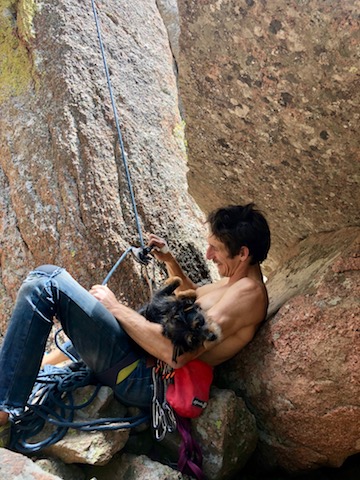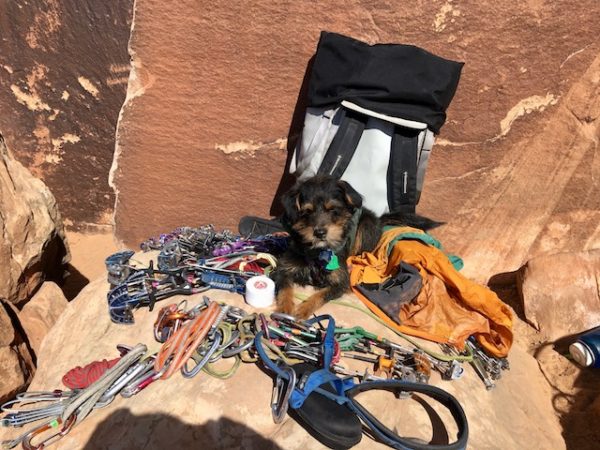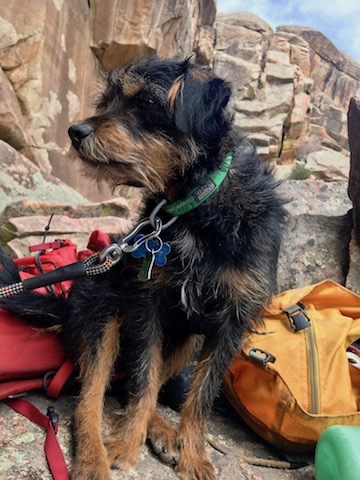Many people who love to rock climb also happen to love, and own, at least one dog.
The two seem to go hand in hand, and yet it so often seems like you have to choose between either climbing or bringing your dog.
Here are some tips so you and your favorite four-legged friend can spend time together while you get to do something you love!

Where to Begin:
It helps knowing some basic etiquette so that you and your dog (and everyone else climbing) can have a good time. Poorly behaved pets put a real damper on most people’s days and can cause issues for all pet owners.
Learning how you and your dog should behave at the crag will help avoid any trouble and you will feel comfortable climbing with your dog.
Before You Go:
Before you go to the crag your dog should know these basic commands and be able to do them when you need him to:
- Sit
- Stay
- Leave it
You should also test the waters before going to a crag and see how your dog does with other people, dogs, and children.
Ideally, your dog should be generally calm, quiet, and well-behaved on hiking trails and on dog-friendly patios as well. Those situations are good tests for your dog!
Often you will encounter all three of these things at once when at a popular climbing destination, and it is important to know your dog can tolerate them.
Dos and Don’ts:
| Do: – Plan at least one “training visit” to the crag where you won’t climb much, but just train your pup – Keep your dog on leash. – Clean up after your pet – Respect people that don’t want your dog too close. – Bring toys and treats | Dont: – Let your dog off leash. – Force you and your dog upon a very crowded area. – Leave your dog unattended. – Bring a dog that you know has a history of problems with people, other dogs, or children |
These are just some basics, and the more you climb with your dog the more you will learn the nuances of each crag and how your dog does in certain situations.
Most Important Things to Remember:
When climbing with your dog here are some of the most important things to remember.
- Choose a location that is accessible for you and your dog. Some crags require boulder hopping and general agility. Older dogs, super small dogs, or some dogs with mobility issues may have a hard time getting there. Research where you want to climb in advance.
- Always keep your dog on leash and make sure they know their basic manners before coming to a crag. If they can’t sit, stay, or leave it then they might not be ready for all the fun and tempting new things they may experience at the crag. Make sure they know before you go.
- Though this one can be frustrating, a very vocal dog can be a real nuisance at the crag. If you have ever been cruxing out and heard the howl of a pup or the screaming of a kid you know what I’m talking about. If your dog just can’t seem to contain himself and has to vocalize all the time, you might consider leaving him at home or trying to bring things that you know will occupy him (like a tasty stuffed Kong).
- Dogs that have a hard time interacting might be best left at home, for their benefit and yours. Don’t force your dog into a stressful situation that may make them fearful or act out.
- Most of all, it’s about having fun. If your dog is not ready for a full day of climbing perhaps start with small hiking days and slowly build up to longer days where you are at the crag and they have to hang out with you. Some dogs get bored easily so always bring fun puzzle toys and treats to keep them busy.

What To Pack:
Having the proper supplies is a great start to having a positive day at the crag with your dog. I never leave home without these things.
- Water and food bowls, with plenty of water and food
- Multiple poop bags and a place to store them
- At least two types of treats
- A bone, ball, and/or puzzle toy
- Leash and harness
- Shade shelter, if climbing somewhere sunny and with limited shade
- Emergency kit
Setting Up For Your Day:
So you’ve picked out a great place to climb and have hiked in with your dog and all your gear. Your standing at the base of your first climb. Now what?
- First, find a nice place to set up your dog. If your pup is calm and won’t interfere with you or your belayer they can be close.
- If they might cause trouble consider setting them up a bit further away, but still in eyesight. A flat spot with shade is the best, but work with what you’ve got. Make sure there aren’t any hazards in the area. For example, setting them up at a really flat spot, but right at the edge of a cliff might not be the best idea.
- Get their bowls filled and toys out. Find a nice place to secure them. I usually use a sling or a cam. This is where a chest harness is really nice. If your dog somehow manages to make their leash tight, it will be pulling across their chest instead of their neck. Always be observant.
- Hang out with your dog in his spot for a bit. Hopefully, he got some energy out on the approach. Make him feel comfortable and secure. If this is your first time ever to the crag just take things slow. Some dogs get stressed when their owner is climbing or belaying out of reach. Make sure your climbing partner is prepared to be patient.
- Test out the waters. Walk away a bit and start to rack up or flake out the rope. Keep an eye on them and see how they respond. If they immediately start to freak out and vocalize or become anxious slowly soothe them. You don’t want them to think that they can always have your attention, but you do want them to feel secure.
- If things are going well and your dog seems content hanging in his spot, start to climb. You starting off as the belayer might be best, but work up to climbing and leaving the ground. If your dog is doing well, that is awesome! If not, take it back a few notches. Go back to making it a safe place for them. Take them on a walk around the crag. Let them sniff and meet other people. Spend more time near them, but not next to them.
- Evaluate how the day went. If you are really lucky you might have one of those incredibly chill dogs that is just happy to hang out wherever you put him. If you do, I envy you. If not, like me, you will have to put in some effort to mold your dog into the crag pup you’ve always wanted. With some patience this can be done. Make a list of what your dog did well and where he could improve. Many behavioral problems can be quickly sorted out with one of our excellent trainers here at Journey Dog Training. You’ll be well on your way to having the best crag dog around!
- Always remember to keep your dog, yourself, and others safe. At the end of the day it is all about everyone having a good experience, so remember to keep that in mind.


